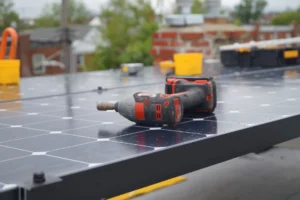Treasury issues guidance on advanced manufacturing production tax credit

Proposal includes definitions and credit amounts for wind and solar components
The U.S. Department of Treasury has issued new guidance on the Section 45X advanced manufacturing production tax credit that passed as part of last year’s Inflation Reduction Act (IRA).
The Treasury proposed regulations to implement the credit, intending to incentivize the production of eligible components within the United States. Qualifying materials include solar and wind energy components, inverters, some battery parts, and applicable critical minerals.
The proposed regulations would affect eligible taxpayers who produce and sell such components and intend to claim the benefit of an advanced manufacturing production credit- including by making elective payments or credit transfer elections.
GO DEEPER: Jose Zayas, EVP of Policy and Programs, American Council on Renewable Energy joined the Factor This! podcast to break down the key components of the historic Inflation Reduction Act, which includes $369 billion dedicated to clean energy and climate change.
“What 45X is demonstrating is that we’re creating a manufacturing renaissance here in the United States that’s being led by U.S. companies,” said Wally Adeyemo, deputy Treasury secretary, on a call with reporters.
The proposals are broken up into four sections. The first provides general rules applicable to the section 45X credit, including defining the term “produced by the taxpayer” for both primary and secondary production. Primary production involves producing an eligible component using non-recycled materials while secondary production involves producing an eligible component using recycled materials.
The proposal would “provide rules for sales to unrelated persons through a person related to the taxpayer, including the rules for a taxpayer to make an election to treat sales of eligible components to related persons (Related Person Election) as if made to unrelated persons.”
It would also provide definitions and credit amounts for certain eligible components, including solar energy components, wind energy components, inverters, qualifying battery components, and phase-out rules, as well as provide definitions and credit amounts for applicable critical minerals that are
eligible components.
“Companies that use contracted manufacturing facilities now have the flexibility to quality for the 45X production tax credit, said Abigail Ross Hopper, president and CEO of the Solar Energy Industries Association (SEIA). “The guidance also includes incentives for production of optimized inverter systems, a critical component for the growing residential solar sector.”
A hearing will be held in February to discuss the proposed regulations, which are open to 60 days of public comment before final rules are issued.
The IRA, implemented in 2022, established a new advanced manufacturing production credit to incentivize the domestic production of various components, including applicable critical minerals used in renewable energy generation, storage, and related manufacturing. The IRA provided a 10% adder to the Investment Tax Credit for projects that utilize domestic content.
The credits will begin phasing out in 2030 and end after 2032 for clean energy components. Critical mineral credits will not phase out.
A Reuters report was referenced in this article.



